-
RESEARCH01-01-2017
Challenges in the end-of-course paper for nursing technical training
Revista Brasileira de Enfermagem. 2017;70(6):1212-1219
Abstract
RESEARCHChallenges in the end-of-course paper for nursing technical training
Revista Brasileira de Enfermagem. 2017;70(6):1212-1219
DOI 10.1590/0034-7167-2016-0105
Views0See moreABSTRACT
Objective:
To verify the opinion of Nursing Technical Training students on the stages of construction of the End-of-Course Paper.
Method:
A cross-sectional study with a qualitative and quantitative approach. A total of 94 students participated from a Nursing Technical course of an institution in the State of São Paulo. A questionnaire was used with assertions, followed by a “Likert Scale” and open field for additional comments.
Results:
The students gave a positive evaluation of the stages involved in completing the paper, but negative responses regarding the time available and obligatory nature (38%). Nevertheless, they understood the essence of the task, in order to foster personal and professional growth; with perspectives to advance in other modalities of the course.
Conclusion:
It is important that course administrators and professors are prepared to support their students, aiming at an effective transformation for the way of thinking and practice in health care.
-
RESEARCH01-01-2017
Stimulus-response time to alarms of the intra-aortic balloon pump: safe care practices
Revista Brasileira de Enfermagem. 2017;70(6):1206-1211
Abstract
RESEARCHStimulus-response time to alarms of the intra-aortic balloon pump: safe care practices
Revista Brasileira de Enfermagem. 2017;70(6):1206-1211
DOI 10.1590/0034-7167-2016-0432
Views0See moreABSTRACT
Objective:
To characterize the sound alarms of the Intra-Aortic Balloon Pump (IABP) during aortic counterpulsation therapy; to measure the stimulus-response time of the team to these; and to discuss the implications of increasing this time for patient safety from the alarm fatigue perspective.
Method:
This is an observational and descriptive study with quantitative and qualitative approach, case study type, carried out in a Cardiac Surgical Intensive Care Unit.
Results:
The most audible IABP alarm was the one of high priority increased-reduced diastolic blood pressure. The stimulus-response time was 33.9 seconds on average.
Conclusion:
Managing the alarms of these equipment is essential to minimize the occurrence of the alarm fatigue phenomenon and to offer a safer assistance to patients who rely on this technology.
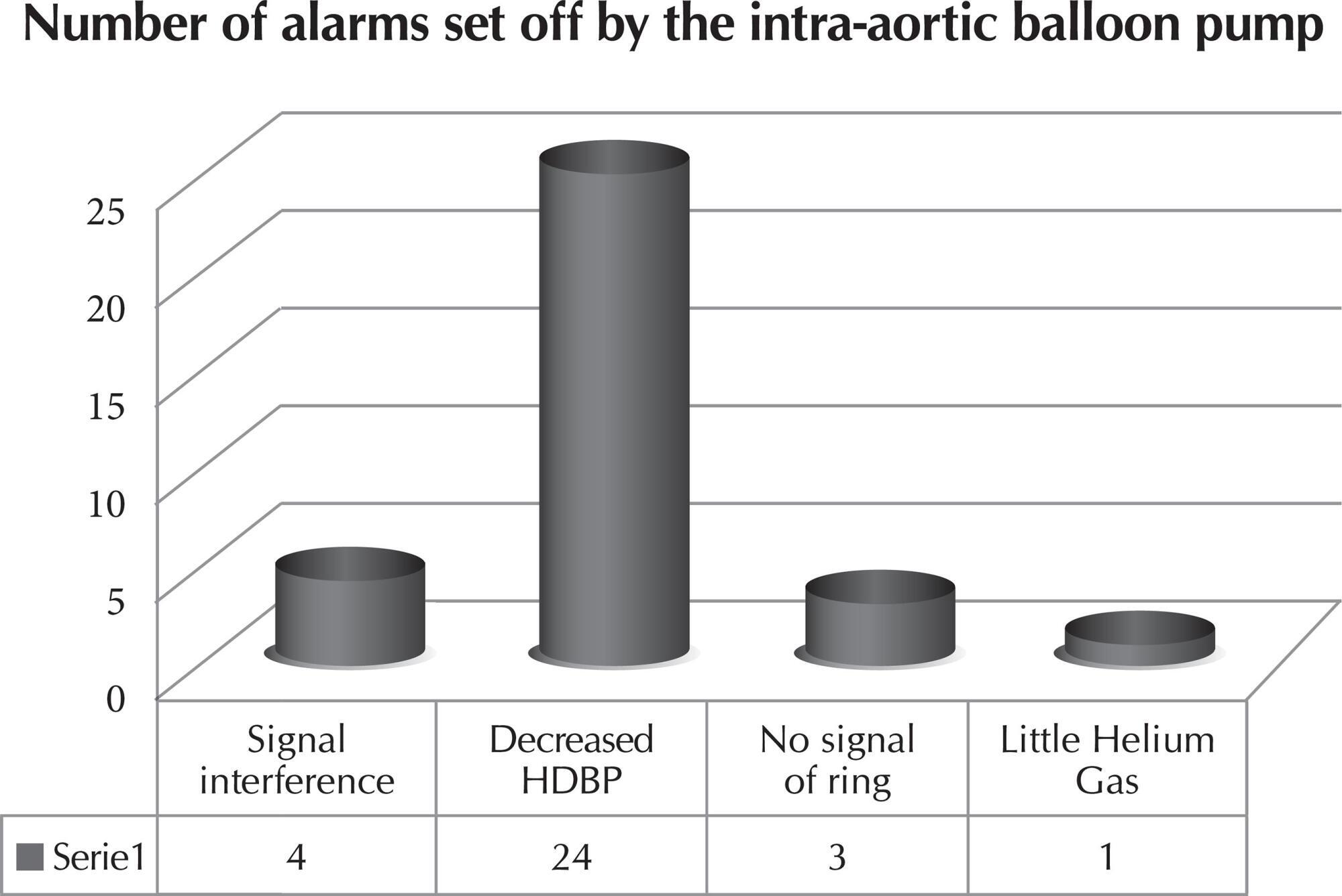
-
RESEARCH01-01-2017
Possibilities of care for serodiscordant couples for HIV who got pregnant
Revista Brasileira de Enfermagem. 2017;70(6):1199-1205
Abstract
RESEARCHPossibilities of care for serodiscordant couples for HIV who got pregnant
Revista Brasileira de Enfermagem. 2017;70(6):1199-1205
DOI 10.1590/0034-7167-2016-0344
Views1See moreABSTRACT
Objective:
Understanding the meaning of pregnancy for heterosexual couples facing serodiscordant situation for HIV, aiming at construction of care possibilities based on subjectivity.
Method:
Phenomenological research, theoretical-philosophical-methodological framework by Martin Heidegger. Research was conducted in a University Hospital in the countryside of Southern Brazil, from September 2013 to May 2014 through a phenomenological interview, with participation of eleven couples.
Results:
For the couples, pregnancy is part of life when they wish to have a child, even when one or both of them already have children from previous relationships. In addition, it is part of life when they consider the risks and do not want to have children in such circumstances anymore, but it happened unexpectedly.
Conclusion:
Understanding reproductive needs and demands of these couples is an aid for qualification and improvement of care as a contribution to nursing care planning towards reproductive health of these couples.
-
RESEARCH01-01-2017
Interactive Theory of Breastfeeding: creation and application of a middle-range theory
Revista Brasileira de Enfermagem. 2017;70(6):1191-1198
Abstract
RESEARCHInteractive Theory of Breastfeeding: creation and application of a middle-range theory
Revista Brasileira de Enfermagem. 2017;70(6):1191-1198
DOI 10.1590/0034-7167-2016-0523
Views0See moreABSTRACT
Objective:
To describe a breastfeeding theory based on King’s Conceptual System.
Method:
Theoretical study that used analysis of concept, assertion synthesis, and derivation of theory for the creation of a new theory.
Results:
King’s system components were associated with elements of the breastfeeding process and a middle-range theory was created, which describes, explains, predicts, and prescribes breastfeeding by analyzing factors that precede and affect it, as well as their consequences on the breastfeeding process.
Conclusion:
The Breastfeeding Interactive Model is abstract enough to be applied in different social, cultural, political, and economic contexts, because it conceptualizes breastfeeding in systemic, dynamic, and procedural aspects. Based on a conceptual model of nursing, it contributes to the scientific construction of the subject; however it can also potentially be applied by other professionals involved in breastfeeding assistance.
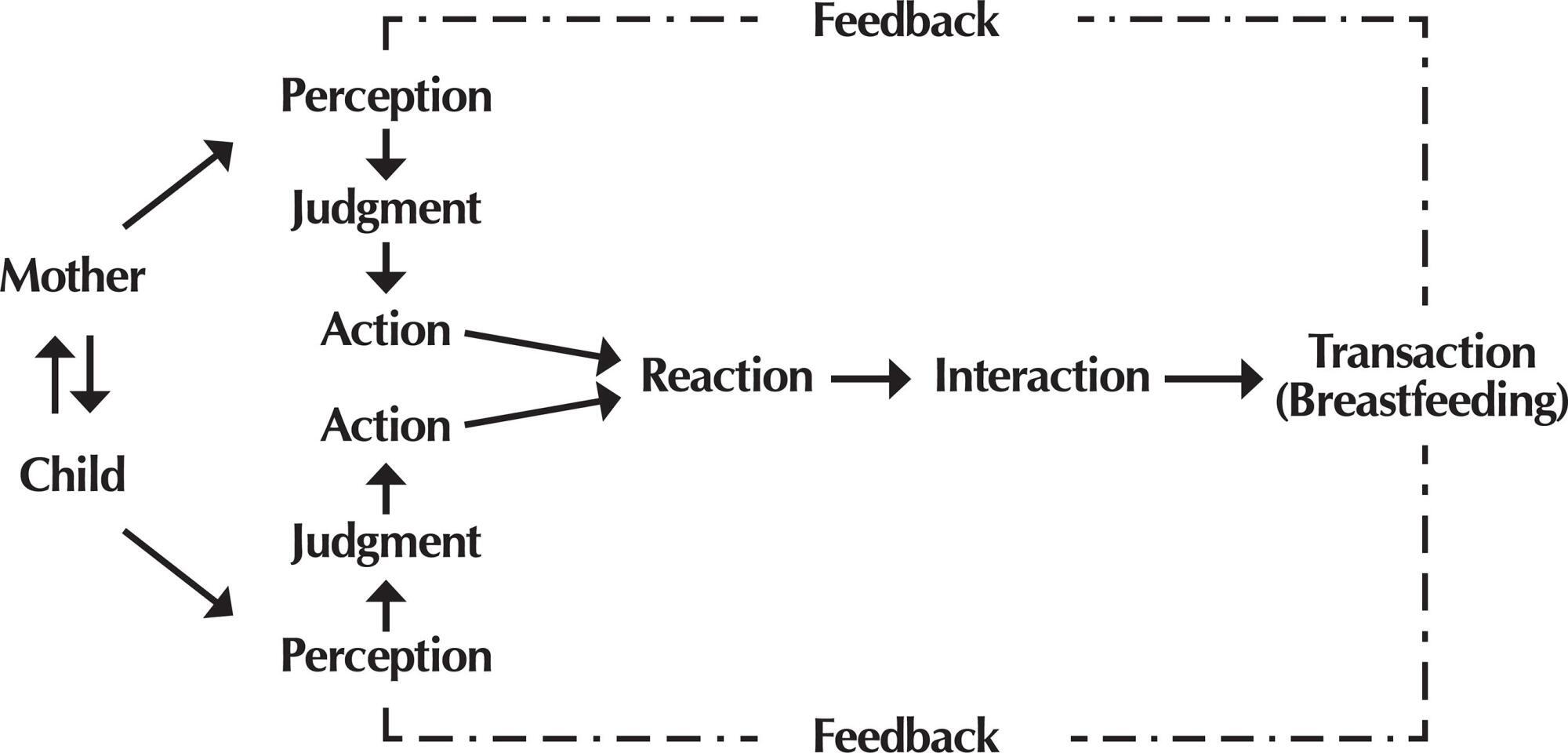
-
RESEARCH01-01-2017
Family resilience and chemical dependency: perception of mental health professionals
Revista Brasileira de Enfermagem. 2017;70(6):1184-1190
Abstract
RESEARCHFamily resilience and chemical dependency: perception of mental health professionals
Revista Brasileira de Enfermagem. 2017;70(6):1184-1190
DOI 10.1590/0034-7167-2016-0476
Views0See moreABSTRACT
Objective:
To learn the perception of health professionals from the Psychosocial Attention Center for Alcohol and Other Drugs regarding the resilience attributes that are critical to family members of psychoactive substance dependents.
Method:
A qualitative descriptive study conducted from February to May 2016, using a focus group technique for data collection. In total, 15 professionals participated in the study: 13 health professionals and two administrative professionals. The statements were recorded and transcribed, and these data were analyzed using the technique of thematic content analysis.
Results:
Health professionals recognize the family resilience attributes needed for efficient and assertive communication, as well as organizational patterns and facilitating family strengths, factors that contribute to improved family relationship and family functionality.
Final considerations:
This study contributed to a perspective of clinical intervention with family members that is not limited to the negative aspects of family relationship and life, such as fragility and family dysfunction.
-
RESEARCH01-01-2017
Efficiency of cleaning and disinfection of surfaces: correlation between assessment methods
Revista Brasileira de Enfermagem. 2017;70(6):1176-1183
Abstract
RESEARCHEfficiency of cleaning and disinfection of surfaces: correlation between assessment methods
Revista Brasileira de Enfermagem. 2017;70(6):1176-1183
DOI 10.1590/0034-7167-2016-0608
Views0See moreABSTRACT
Objective:
to assess the correlation among the ATP-bioluminescence assay, visual inspection and microbiological culture in monitoring the efficiency of cleaning and disinfection (C&D) of high-touch clinical surfaces (HTCS) in a walk-in emergency care unit.
Method:
a prospective and comparative study was carried out from March to June 2015, in which five HTCS were sampled before and after C&D by means of the three methods. The HTCS were considered dirty when dust, waste, humidity and stains were detected in visual inspection; when ≥2.5 colony forming units per cm2 were found in culture; when ≥5 relative light units per cm2 were found at the ATP-bioluminescence assay.
Results:
720 analyses were performed, 240 per method. The overall rates of clean surfaces per visual inspection, culture and ATP-bioluminescence assay were 8.3%, 20.8% and 44.2% before C&D, and 92.5%, 50% and 84.2% after C&D, respectively (p<0.001). There were only occasional statistically significant relationships between methods.
Conclusion:
the methods did not present a good correlation, neither quantitative nor qualitatively.
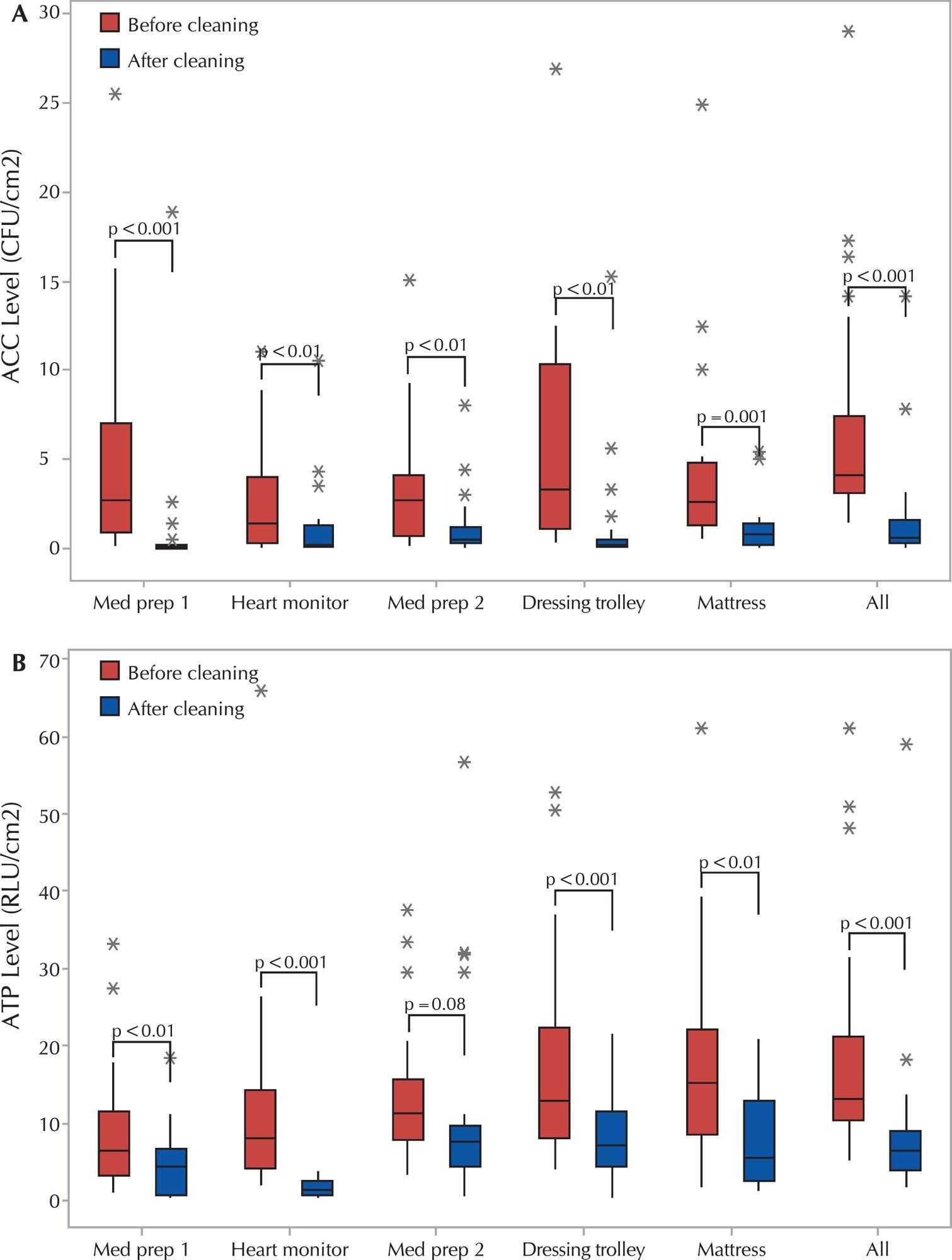
-
RESEARCH01-01-2017
Cultural adaptation of The End-Stage Renal Disease Adherence Questionnaire for hemodialysis patients
Revista Brasileira de Enfermagem. 2017;70(6):1169-1175
Abstract
RESEARCHCultural adaptation of The End-Stage Renal Disease Adherence Questionnaire for hemodialysis patients
Revista Brasileira de Enfermagem. 2017;70(6):1169-1175
DOI 10.1590/0034-7167-2016-0519
Views0See moreABSTRACT
Objective:
To describe the stages in the cultural adaptation of “The End-Stage Renal Disease Adherence Questionnaire” for use in Brazil.
Method:
A descriptive, transversal study with a quantitative approach. The cultural adaptation followed the steps of translation, professional committee, back translation, panel of patients and pretest.
Results:
the translation stage created a version in Portuguese that was analyzed by specialists, who suggested alterations in the title, seven sentences in the questions and three sets of answers. In the panel of patients phase, two questions were altered. The back translation considered the original characteristics of the instrument were maintained, likewise there were no modifications in the pretest phase. The third version written in Portuguese was considered to be the final version of the questionnaire.
Conclusion:
this instrument should facilitate nursing care management in hemodialysis, enabling the monitoring of adherence among these patients and also contribute to improving the indicators of morbidity and mortality.
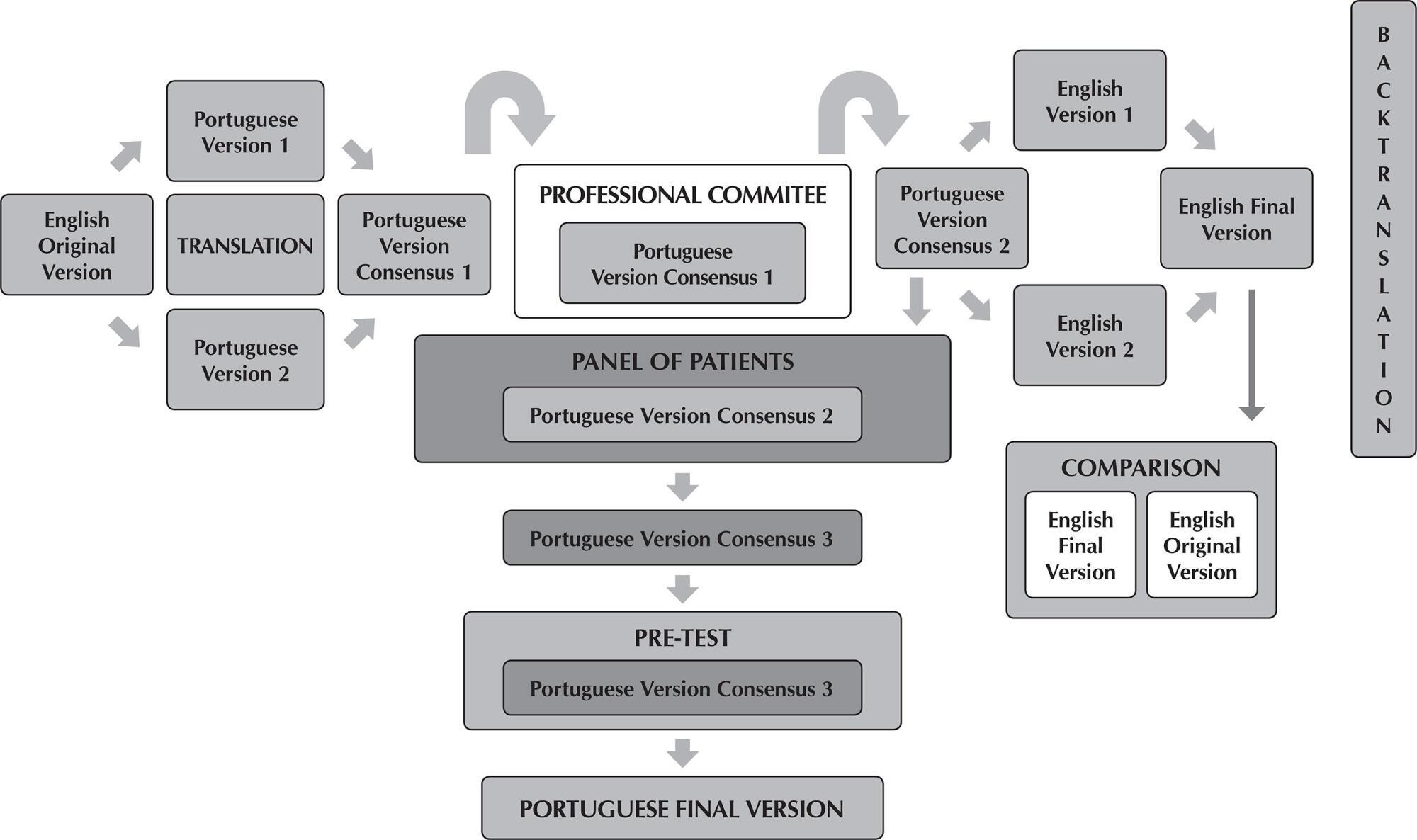
-
RESEARCH01-01-2017
Revalidation of game for teaching blood pressure auscultatory measurement: a pilot study
Revista Brasileira de Enfermagem. 2017;70(6):1159-1168
Abstract
RESEARCHRevalidation of game for teaching blood pressure auscultatory measurement: a pilot study
Revista Brasileira de Enfermagem. 2017;70(6):1159-1168
DOI 10.1590/0034-7167-2016-0578
Views0See moreABSTRACT
Objective:
To adapt a pre-existing educational game, making it specific to the teaching of blood pressure auscultatory measurement, and to apply this game in a pilot study.
Method:
The original game cards were altered by the authors and submitted to content validation by six experts in the field. After redesigns, the game was applied to 30 subjects, who answered a questionnaire (pre-test and post-test) on auscultatory measurement. Data were analyzed descriptively and by the paired Student’s t-test and paired Wilcoxon test.
Results:
Throughout the content validation process, 17 of the 28 original cards were modified. Of these 17 cards, 13 obtained 80% agreement, and the rest were modified according to the judges’ suggestions. The obtained grades significantly increased between pre- and the post-test.
Conclusion:
It was concluded that the reformulated game presented satisfactory evidence of content validity. Its use as a teaching-learning method was effective for this sample.
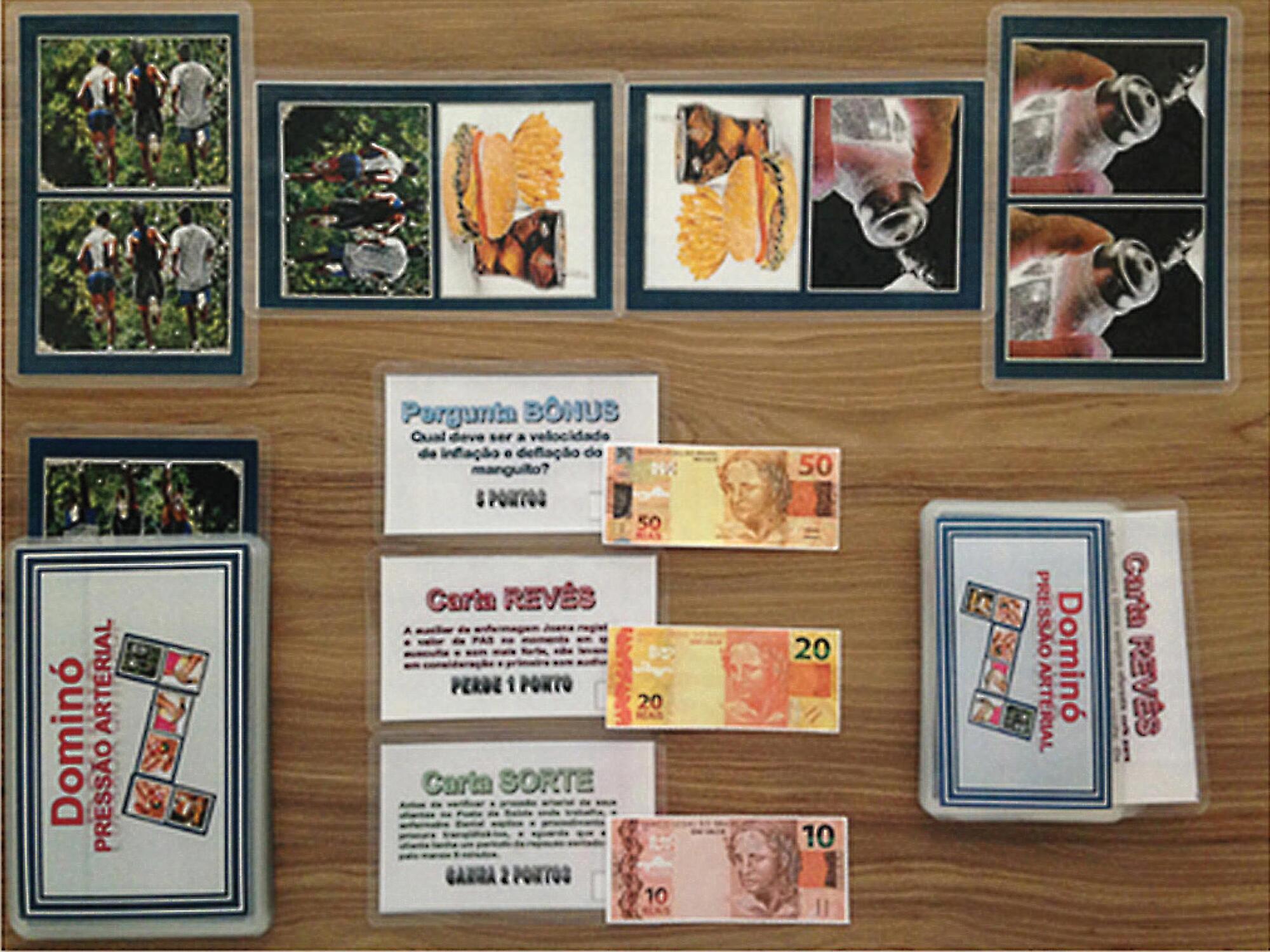
-
EXPERIENCE REPORT01-01-2018
Clinical and epidemiological teaching of dengue through simulated practice
Revista Brasileira de Enfermagem. 2018;71(2):451-456
Abstract
EXPERIENCE REPORTClinical and epidemiological teaching of dengue through simulated practice
Revista Brasileira de Enfermagem. 2018;71(2):451-456
DOI 10.1590/0034-7167-2016-0503
Views2See moreABSTRACT
Objective:
to describe the experience of clinical teaching on dengue and the practice of epidemiological surveillance using problematization methodology.
Method:
report of experience on educational activity with undergraduate nursing students, held in March 2016, at a public university in the city of São Paulo, conceived in four stages: dialogic lecture, active search of Aedes aegypti, case study and simulation of nursing consultation to individuals with dengue.
Results:
The activity allowed to retrieve previous knowledge about the disease, respond to exercises that addressed different clinical situations and epidemiological surveillance, including in situ evaluation of possible mosquito outbreaks, and discuss the need to expand prevention and health of the individual and the community, the impact of the media in the dissemination of cases and the coping difficulties experienced in the different levels of attention.
Conclusion:
the methodology adopted enabled qualified training of students to cope with dengue.

-
ORIGINAL ARTICLE07-18-2022
Beliefs, knowledge, actions of nursing techniques in breastfeeding in pain management in immunization
Revista Brasileira de Enfermagem. 2022;75(6):e20210546
Abstract
ORIGINAL ARTICLEBeliefs, knowledge, actions of nursing techniques in breastfeeding in pain management in immunization
Revista Brasileira de Enfermagem. 2022;75(6):e20210546
DOI 10.1590/0034-7167-2021-0546
Views1See moreABSTRACT
Objective:
Understand the beliefs, knowledge, and actions of nursing technicians on breastfeeding as a form of non-pharmacological intervention to relieve pain in newborns and infants during immunization.
Methods:
Qualitative study carried out through semi-structured interviews with nine nursing technicians from three Basic Health Units in a city in the state of São Paulo. The theoretical approach of the Belief Model and the methodological framework of Thematic Analysis supported this study.
Results:
Three themes originated: Beliefs, Knowledge, and Actions of nursing technicians.
Final considerations:
Despite knowledge about the benefits of breastfeeding as the most effective method for relieving pain in newborns and infants during vaccination, their restrictive beliefs overrode the evidence, leading them to act in ways that discourage or prevent the mother from breastfeed during vaccination. Formal training is recommended to align with current evidence-based practices.
-
REVIEW12-08-2023
Educational technologies for accident prevention due to falls in childhood: a scoping review
Revista Brasileira de Enfermagem. 2023;76:e20220807
Abstract
REVIEWEducational technologies for accident prevention due to falls in childhood: a scoping review
Revista Brasileira de Enfermagem. 2023;76:e20220807
DOI 10.1590/0034-7167-2022-0807
Views2See moreABSTRACT
Objectives:
to map evidence on educational technology use for accident prevention due to falls in childhood.
Methods:
a scoping review, carried out in October and November 2022, in the MEDLINE, Web of Science, BDENF and CINAHL databases and LILACS bibliographic index. There was no delimitation of language or time. Data were extracted and analyzed descriptively by two independent researchers. The research protocol was registered in the Open Science Framework.
Results:
twenty-six studies were selected. Booklets, pamphlets and leaflets were the most used technologies, presenting health services as the most frequent environment to develop research on fall prevention. The technologies developed were important outcomes: increased knowledge of children, family members, caregivers, health and education professionals.
Conclusions:
educational technology use makes it possible to increase knowledge, adopt safe practices and reduce falls.

-
REVIEW03-15-2024
Resources for health literacy among caregivers of prematurely born children: a scoping review
Revista Brasileira de Enfermagem. 2024;77(1):e20230062
Abstract
REVIEWResources for health literacy among caregivers of prematurely born children: a scoping review
Revista Brasileira de Enfermagem. 2024;77(1):e20230062
DOI 10.1590/0034-7167-2023-0062
Views1See moreABSTRACT
Objectives:
to map the available evidence on resources used to promote health literacy among caregivers of prematurely born children during outpatient follow-up.
Methods:
the Joanna Briggs Institute’s scope review protocol was utilized. The search encompassed six databases, incorporating studies from 2012 to 2022.
Results:
the three included publications revealed that the resources employed are: mobile applications, phone calls, individual counseling, videos, educational pamphlets, and group discussions. Implementing an education protocol during the transition home enhances scientifically grounded health promotion rates.
Conclusions:
there is limited literature addressing the health literacy of these caregivers. The nursing team plays a crucial role in health education and in developing resources applicable to these families.

-
ORIGINAL ARTICLE01-13-2024
Social representations of oncologic surgery for patients with cancer
Revista Brasileira de Enfermagem. 2024;77(6):e20230273
Abstract
ORIGINAL ARTICLESocial representations of oncologic surgery for patients with cancer
Revista Brasileira de Enfermagem. 2024;77(6):e20230273
DOI 10.1590/0034-7167-2023-0273
Views2See moreABSTRACT
Objectives:
to analyze the social representations of patients with cancer regarding oncologic surgery.
Methods:
a qualitative study based on Social Representation Theory was conducted with 126 participants between October 2021 and May 2022 in a public hospital in Rio de Janeiro. A characterization questionnaire, free evocations of the inducing term “surgery”, and semi-structured interviews with 60 participants were applied. Data were analyzed using Microsoft Excel® and IRaMuTeQ.
Results:
the central core of the representation is composed of fear, cure, hope, and removing the disease. The analysis of interviews resulted in six classes that highlight the social changes caused by treatment as well as the need for a support network to cope with the surgical process.
Final Considerations:
the representations reflect fear and hope towards the procedure and the desire to remove the disease, thus translating the cure through surgery.

-
ORIGINAL ARTICLE01-13-2024
Nurses’ perspectives on the use of telemonitoring in the management of people with diabetes and hypertension
Revista Brasileira de Enfermagem. 2024;77(6):e20230481
Abstract
ORIGINAL ARTICLENurses’ perspectives on the use of telemonitoring in the management of people with diabetes and hypertension
Revista Brasileira de Enfermagem. 2024;77(6):e20230481
DOI 10.1590/0034-7167-2023-0481
Views3See moreABSTRACT
Objectives:
to understand the perspective of nurses on the use of telemonitoring in the management of people with type 2 diabetes mellitus and arterial hypertension in primary care.
Methods:
this qualitative research involved sixteen nurses from eight municipalities in Paraná. Data were collected between November 2022 and January 2023 through inperson or remote interviews, which were audio-recorded and subjected to content analysis.
Results:
according to the nurses, telemonitoring enhances users’ knowledge about these conditions, communication and connection with the team, and productivity. However, the lack of electronic resources and equipment, high staff turnover, low user adherence, and the limited availability of professional time present significant challenges.
Final Considerations:
the effective implementation and operation of telemonitoring in the management of people with diabetes and hypertension involve both potential benefits and barriers. It is essential to have the availability of human and technological resources, managerial support, and the commitment of professionals and users.
-
ERRATUM01-13-2024
ERRATUM
Revista Brasileira de Enfermagem. 2024;77(6):e2024n6e08
Abstract
ERRATUMERRATUM
Revista Brasileira de Enfermagem. 2024;77(6):e2024n6e08
DOI 10.1590/0034-7167.20247706e08
Views2In the article “Brazilian nursing specific situation, middle and micro-range theories: a bibliometric study”, with DOI number: , published in Revista Brasileira de Enfermagem, 2024;77(4):e20230520, Chart 1:Where it read:[…]See more -
ORIGINAL ARTICLE09-29-2022
Palliative care production for health professionals in the context of home care
Revista Brasileira de Enfermagem. 2022;75(1):e20210030
Abstract
ORIGINAL ARTICLEPalliative care production for health professionals in the context of home care
Revista Brasileira de Enfermagem. 2022;75(1):e20210030
DOI 10.1590/0034-7167-2021-0030
Views1See moreABSTRACT
Objectives:
to analyze palliative care production developed by health professionals to home care patients.
Methods:
this is an exploratory study, with a qualitative approach, using the transpersonal care theoretical framework. Thirteen interviews were conducted with health professionals and 18 observations were conducted on different cases. Content analysis was performed using MAXQDA©.
Results:
actions performed: maintenance and follow-up measures to people eligible for palliative care, in acts of dialogue and “listening” to caregivers and users, conducting guidelines for the care and self-care process, performing technical procedures, delivery of materials, referrals and medical prescriptions to users.
Final Considerations:
it is perceived the need for advances in the implementation of government policies in Brazil that insert palliative care into the Health Care Network through educational, managerial and care actions that ensure human dignity, thus allowing the development of these and other palliative care interventions.
-
06-11-2021
Educational technology on COVID-19 for families of children and adolescents with sickle cell disease
Revista Brasileira de Enfermagem. 2021;74:e20201045
Abstract
Educational technology on COVID-19 for families of children and adolescents with sickle cell disease
Revista Brasileira de Enfermagem. 2021;74:e20201045
DOI 10.1590/0034-7167-2020-1045
Views1See moreABSTRACT
Objective:
to construct and validate educational technology on COVID-19 and essential care for families of children/adolescents with sickle cell disease.
Methods:
this is a methodological study, in three stages: 1) elaborated educational technology, using the Doak, Doak and Root theoretical-methodological model; 2) content and appearance validation by the content validity coefficient. Delphi technique was applied in two rounds (Delphi I [12 judges]/Delphi II [11 judges]); 3) conducting a pilot test with six families.
Results:
“Sickle cell disease and COVID-19: essential care” included: consequences of COVID-19 in sickle cell disease, guidelines for reducing the risks of contracting the virus and having complications, signs and symptoms of COVID-19, guidelines in case of child/adolescent with suspicion or symptoms of COVID-19. Global content validity coefficient (Delphi II): 0.98.
Conclusion:
educational technology presented content and appearance validity for families of children/adolescents with sickle cell disease, related to COVID-19.
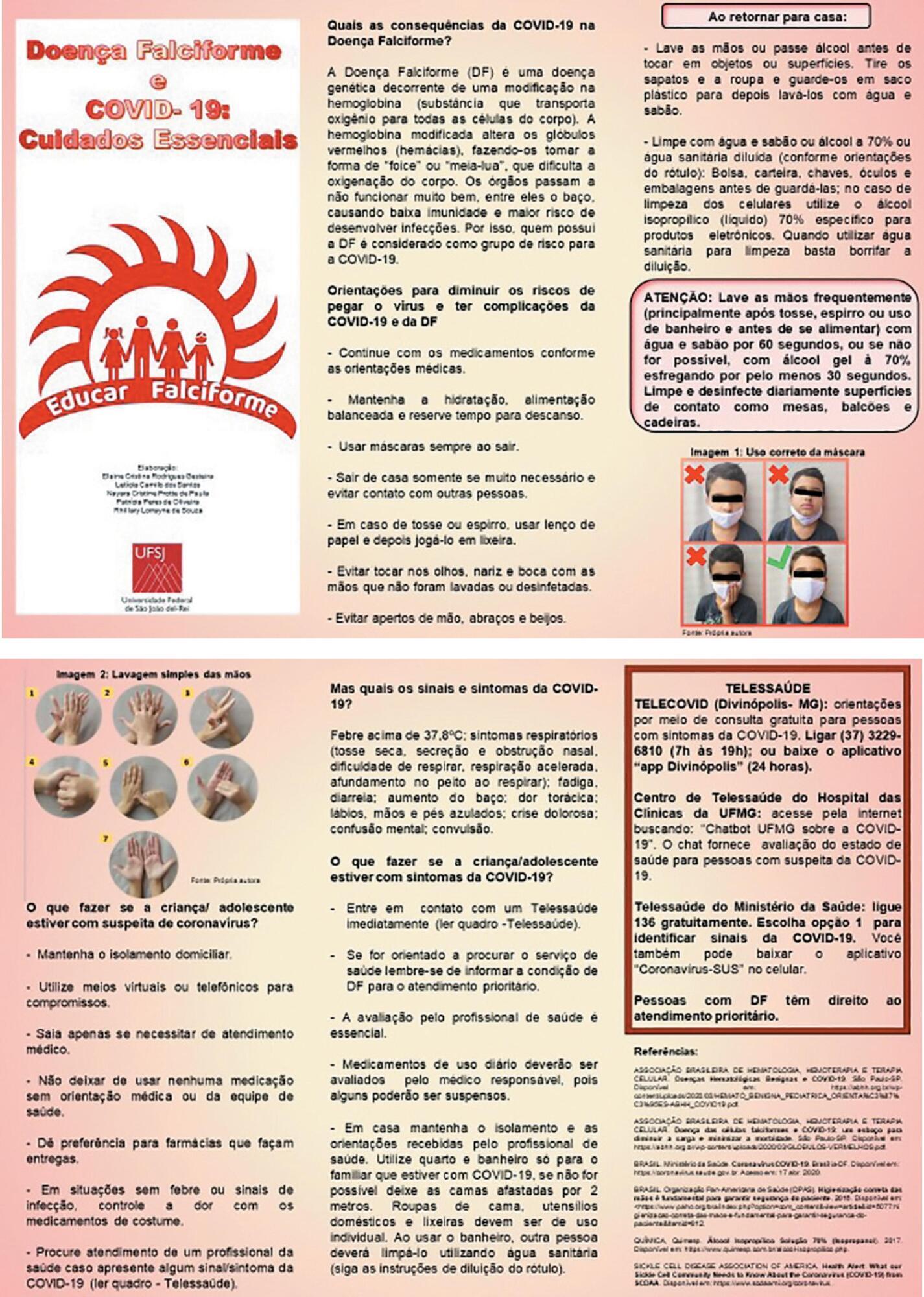
-
07-05-2021
Educational technology for bathing/hygiene of elders at home: contributions to career knowledge
Revista Brasileira de Enfermagem. 2021;74:e20200890
Abstract
Educational technology for bathing/hygiene of elders at home: contributions to career knowledge
Revista Brasileira de Enfermagem. 2021;74:e20200890
DOI 10.1590/0034-7167-2020-0890
Views0See moreABSTRACT
Objective:
to build and validate an educational booklet for bathing and hygiene of elders at home.
Methods:
a methodological study, developed through data collection in literature and situational diagnosis, booklet construction, material qualification through validation by expert judges (11 nurses) and target audience (30 caregivers). Data were analyzed descriptively. The minimum content validity index of 0.80 was considered.
Results:
in content and appearance validation, experts assigned Content Validity Index global of 0.92, while for assessment of the material’s suitability, the booklet was classified as “superior”, with an average of 90%. In the validation of caregivers, the overall Content Validity Index was 1.0.
Conclusion:
the booklet was successfully validated and can be considered in the context of health education and collaborate with an adequate and safe practice of bathing and hygiene of elders at home.
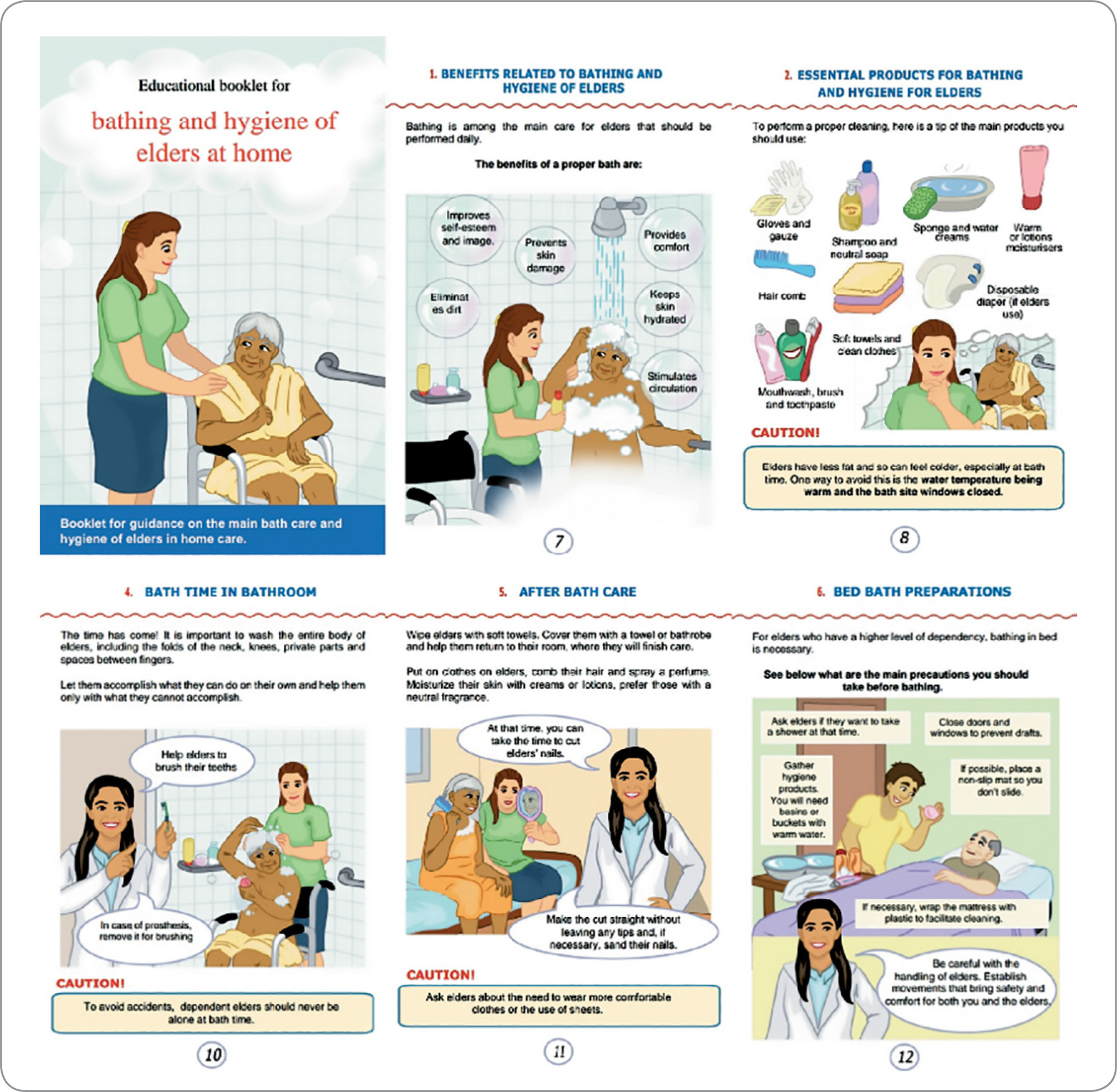
-
ORIGINAL ARTICLE08-10-2020
Burden on caregivers of patients with sequelae of cerebrovascular accident
Revista Brasileira de Enfermagem. 2020;73(6):e20180868
Abstract
ORIGINAL ARTICLEBurden on caregivers of patients with sequelae of cerebrovascular accident
Revista Brasileira de Enfermagem. 2020;73(6):e20180868
DOI 10.1590/0034-7167-2018-0868
Views0See moreABSTRACT
Objectives:
to evaluate the burden and its relationship with the sociodemographic characteristics of caregivers of people with sequelae of stroke.
Methods:
a cross-sectional, exploratory, and quantitative study was conducted with 151 caregivers of people with sequelae of stroke, through home interviews between September and December 2017. Results: there was a general mean of low burden. The items that indicated the worst changes were: “My time for social activities with friends,” “My time for family activities,” “My ability to cope with stress,” and “My physical functioning.” There was an association of burden with the female sex and with caregivers who have been assisting for longer.
Conclusions:
the results allow us to reflect on the need to create a policy aimed at family caregivers to reduce the impact of care delivery.
-
03-19-2021
Validity and reliability of Kessler Psychological Distress Scale for Brazilian elderly: a cross-sectional study
Revista Brasileira de Enfermagem. 2021;74:e20200365
Abstract
Validity and reliability of Kessler Psychological Distress Scale for Brazilian elderly: a cross-sectional study
Revista Brasileira de Enfermagem. 2021;74:e20200365
DOI 10.1590/0034-7167-2020-0365
Views0See moreABSTRACT
Objective:
to verify the validity and reliability of the Psychological Distress Scale for screening mental distress.
Methods:
a cross-sectional study with 75 elderly people. Psychological Distress scale and Self Reporting Questionnaire were used. Criterion validity was verified using Spearman’s correlation and diagnostic accuracy measures. Cronbach’s alpha coefficient was used to investigate reliability.
Results:
the total internal consistency of the Psychological Distress Scale was α=0.844. Concurrent validity between this instrument and the Self Reporting Questionnaire was ρ=0.722 (p<0.001). The best cut-off point for screening mental distress among elderly people was a total score greater than 14, with sensitivity equal to 75.47% and specificity equal to 85.0%.
Conclusions:
the scale was robust for screening mental distress, given its high reliability, in terms of homogeneity, and adequate criterion validity, whose best cut-off point for screening was a score greater than 14.
-
ORIGINAL ARTICLE10-05-2020
Professional master program: Preparing the nurse of the future
Revista Brasileira de Enfermagem. 2020;73:e20200007
Abstract
ORIGINAL ARTICLEProfessional master program: Preparing the nurse of the future
Revista Brasileira de Enfermagem. 2020;73:e20200007
DOI 10.1590/0034-7167-2020-0007
Views0See moreABSTRACT
Objective:
Analyze the results of knowledge production from a graduate program for master’s degree in nursing.
Method:
This is a qualitative retrospective documentary study. Data were collected from the university library repository and the program website. In total, 83 dissertations were found, analyzed and arranged into five groups: worker’s health, care management, systematization of nursing care, health education, and nursing care.
Results:
The results indicate good practices such as manuals, guides, protocols, software, and products for systematization of care. They indicate concern about changing the reality with care practices and interventions, health education and continuing education.
Final considerations:
This study showed student commitment to the fields of practice when choosing the project theme. Students presented an intention to improve care, management, education and research, in the various dimensions of the profession.
-
ORIGINAL ARTICLE12-21-2020
Physical violence and verbal abuse against nurses working with risk stratification: characteristics, related factors, and consequences
Revista Brasileira de Enfermagem. 2020;73:e20190882
Abstract
ORIGINAL ARTICLEPhysical violence and verbal abuse against nurses working with risk stratification: characteristics, related factors, and consequences
Revista Brasileira de Enfermagem. 2020;73:e20190882
DOI 10.1590/0034-7167-2019-0882
Views0See moreABSTRACT
Objective:
to analyze the characteristics, related factors, and consequences of physical violence and verbal abuse against nurses working with risk stratification.
Methods:
a cross-sectional, descriptive and quantitative study carried out with 80 nurses who work with risk stratification in emergency services. Data were collected using an adapted instrument and analyzed using (uni)bivariate inferential statistics.
Results:
companions were the main perpetrators of verbal abuse (86.1%); and patients inflicted physical violence (100%). Professionals with up to five years of experience are 74% less likely to suffer physical violence (p=0.029). Women suffer 5.83 times more verbal abuse than men (p=0.026). Sadness (15.8%) and fear of the aggressor (15.3%) were the main consequences of verbal abuse; and fear of the aggressor (22.2%) and stress (22.2%) were results of physical violence.
Conclusion:
violence is influenced by institutional, professional and client aspects. Therefore, coping with it requires multidimensional strategies.

-
ORIGINAL ARTICLE06-01-2020
Prisoners of suffering: perception of women on violence practiced by intimate partners
Revista Brasileira de Enfermagem. 2020;73:e20190219
Abstract
ORIGINAL ARTICLEPrisoners of suffering: perception of women on violence practiced by intimate partners
Revista Brasileira de Enfermagem. 2020;73:e20190219
DOI 10.1590/0034-7167-2019-0219
Views0See moreABSTRACT
Objective:
to describe the perceptions of women, prisoners or partners of imprisoned men who experience/experienced intimate partner violence, and how they cope with this situation.
Method:
a descriptive exploratory study with a qualitative approach conducted with 21 women. Empirical data collected between March and August 2018, through audio-recorded semi-structured interviews, were submitted to thematic content analysis.
Results:
women reported experiencing different forms of violence, which triggered suffering and negative commitment in their lives, far beyond the act itself, especially by the emotional and physical marks and their consequences. They also realize that coping with violence is individual responsibility, lived in the counterpoint between the desire to overcome it and passivity.
Final considerations:
intimate partner violence was uniquely revealed by women as a solitary experience, with permanent consequences in the physical, emotional, patrimonial, sexual and moral spheres, and limited internal and external resources make it difficult to cope with it.
-
08-20-2021
Validation of an educational game about first aid for schoolchildren
Revista Brasileira de Enfermagem. 2021;74(6):e20201107
Abstract
Validation of an educational game about first aid for schoolchildren
Revista Brasileira de Enfermagem. 2021;74(6):e20201107
DOI 10.1590/0034-7167-2020-1107
Views0See moreABSTRACT
Objectives: to validate the content and appearance of an educational game about first aid for schoolchildren with experts in education and health.
Methods: this is a methodological, quantitative and descriptive research, carried out using the Delphi technique, using an online collection instrument, covering 55 items of the game. Content and appearance assessment was performed by 26 judges. The data were analyzed using Content Validity index.
Results: the final prototype is presented in a board format, composed of four buildable pawns and 117 cards between questions, alerts and challenges. Overall Content Validity index of 0.95 and greater than 0.8 was obtained for all items in two Delphi rounds.
Conclusions: the educational game validated by experts is a pedagogical tool for teaching first aid to schoolchildren as an option to traditional educational practices.
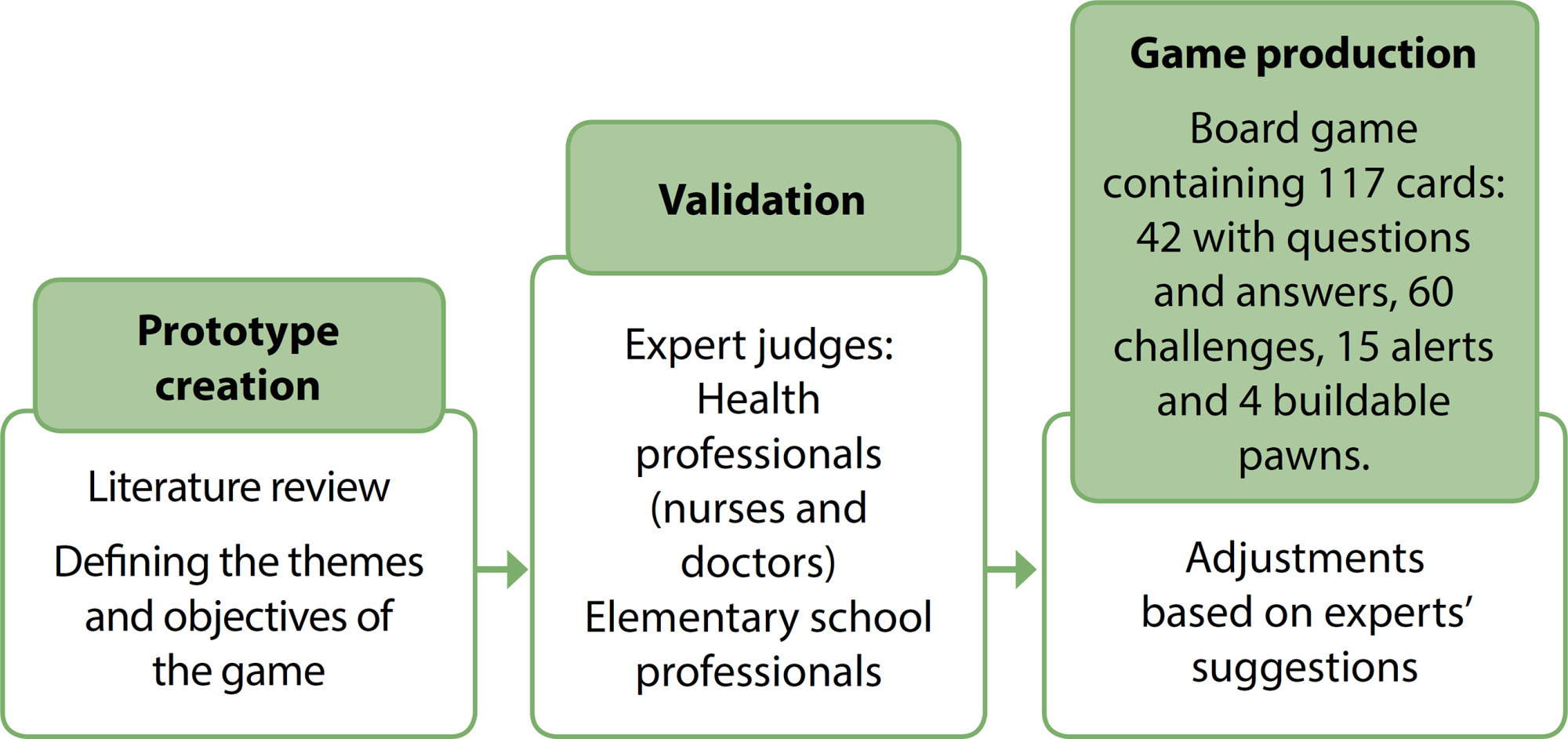
Search
Search in:
Nuvem de Tags
Adolescente (85) Atenção Primária à Saúde (239) COVID-19 (91) Criança (91) Cuidados de Enfermagem (269) Educação em Enfermagem (151) Educação em Saúde (139) Enfermagem (930) Enfermagem Pediátrica (86) Estudantes de Enfermagem (77) Estudos de Validação (131) Família (87) Idoso (208) Promoção da Saúde (99) Qualidade de Vida (104) Saúde do Trabalhador (86) Saúde Mental (145) Saúde Pública (82) Segurança do Paciente (150) Tecnologia Educacional (100)



